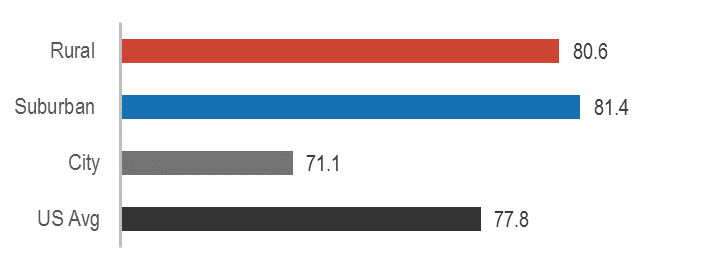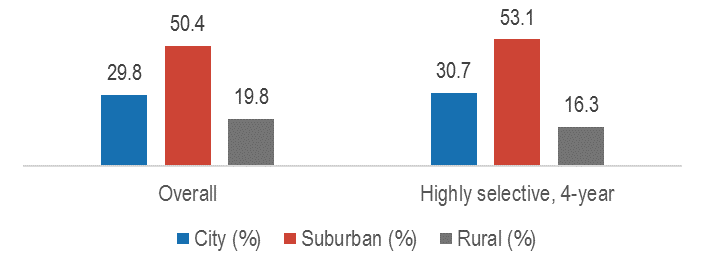Supporting Postsecondary Access and Success for Rural Students
By Sindy Lopez and Emily Schwartz
September 23, 2019
This post originally appeared on the Ithaka S+R blog.
Reading Time: 5 minutes

The American Talent Initiative (ATI), a coalition of high-graduation-rate colleges and universities committed to enrolling and graduating more low- and middle-income students, began a webinar series on special interest topics that we hope will elevate best practices in recruiting talented low- and moderate-income students. This summer, we hosted a webinar on the challenges of identifying, recruiting, and enrolling rural students. In this post, we summarize the key research and best practices presented on the webinar.
What is the definition of “rural”?
There is more than one definition in use for defining rurality, so when developing an institutional strategy to recruit and enroll more rural students, it is essential for institutions to define what rural means. The National Center for Education Statistics (NCES) and the Census Bureau define rural areas as regions with fewer than 50,000 people, located several miles from urbanized areas and clusters. Individual colleges and universities have also adapted their own definitions based on federal definitions or other more institutional-based classifications.
Why is enrolling rural students important?
According to the Urban Institute, 41 million Americans live 25 miles or more from the nearest post-secondary institution, especially in rural areas. When considering high-graduation rate institutions, like those eligible for ATI, the distance for many Americans grows. Please see this blog post “Prepare to Travel: Across the U.S. Access to High-Completion-Rate Colleges Uneven” to learn more.
Since individuals who enroll in college are most likely to do so close to their home, this limited access has profound effects on the social well being and mobility of those in rural communities. Rural counties with the lowest educational attainment experience higher levels of poverty, unemployment, and population loss. If America’s high-graduation-rate colleges and universities provide greater access and opportunity for talented low-income rural students, they have the potential not only to propel these students’ social mobility, but to provide benefits to their communities as well.
It is clear that there is a lot of talent in rural communities. According to NCES data, compared to their urban peers and the national average, rural students have scored higher on the National Assessment of Education Progress. Rural students are also more likely to graduate from high school compared to their urban peers and the national average.
Figure 1: Average National Assessment of Educational Progress (NAEP) mathematics and reading scale score of 8th-grade public school students, by school locale

Source: NCES, National Assessment of Educational Progress (NAEP) 2015
Figure 2: Average graduation rate for high school students, by school locale

Source: NCES, Common Core of Data 2009-10
Figure 3: Overall and selective college enrollment, by urbanicity

Source: NCES, Education Longitudinal Study of 2002 (ELS:2002), High School Sophomore
Despite their strong academic credentials, talented rural students are not attending the institutions that provide a greater probability of graduating and upward social mobility. Based on data from NCES’ Educational Longitudinal Study of 2002, only 16 percent of rural students enroll in highly selective colleges compared to 30 percent and 53 percent of their urban and suburban peers. The NCES definition of “highly selective” refers to four-year institutions whose first-year students’ test scores place them roughly in the top fifth of all baccalaureate institutions, which includes about 250 ATI eligible institutions. As one metric, holding constant academic and social characteristics, rural students were 2.5 times less likely to enroll in the top 50 national universities and top 50 national liberal arts colleges on US News & World Report’s 2004 list.
What are the current enrollment challenges faced by rural students?
Rural students face multiple challenges along the path from recruitment to enrollment. Rural school districts are geographically distant which makes it difficult for colleges to visit since it is costly and time intensive. In addition, talented low- and moderate-income rural students may have limited awareness of their college options. Recruiting pipelines are often based on existing relationships with high schools or community-based organizations that are primarily located in urban and suburban areas where there is also a critical mass of students to recruit.
Rural students are also less likely than their urban and suburban peers to have access to the resources needed to apply to and be successful in college, like high-speed broadband internet, academically rigorous courses, extracurricular opportunities, and fully staffed high school counseling offices.
It is also important to note that rural students come from diverse social and economic backgrounds and already experience disparities in access to higher education. For example, as is the case with lower-income students from any region, rural students from lower-income families are less likely to pursue post-secondary opportunities than their higher-income peers. Additionally students of color from rural communities face unique challenges compared to their white rural peers.
What strategies have institutions and organizations used to improve access and success for rural students?
Strategies institutions have used to recruit rural students include admissions staff from multiple institutions traveling together to rural areas , outreach that directly engages counselors and students, offering campus visits though fly in programs, and making connections through virtual advising programs and online prep courses. Specific examples include:
- Matriculate, a national nonprofit organization, leverages a near-to-peer advising model and technology to reach high-achieving, low-income high school students remotely, particularly in smaller towns and more rural areas, by providing them with the knowledge, skills, confidence, and role models they need to apply to, enroll in, and graduate from top schools. To do this, Matriculate recruits, selects, and rigorously trains undergraduate college students at colleges across the country to serve as virtual college advisors. In partnership with Bloomberg Philanthropies’ college access and success initiative, CollegePoint, Matriculate aims to help 65,000 students apply, enroll, and graduate from high graduation rate colleges.
- University of Chicago’s Emerging Rural Leaders Program offers two summer programs to freshmen and juniors from rural and small-town high schools. Participating students attend fully funded summer session programs that help rural students navigate the college application process, develop academic skills, and experience college life on campus. The program also provides a yearly fly-in opportunity to UChicago’s campus for high school counselors, principals, and administrators from rural and small-town high schools to learn more about the highly selective college admissions process. Select students from rural and small-town high schools who enroll at UChicago are eligible for the Emerging Rural Leaders scholarship and guaranteed paid summer internships. In addition to select merit scholarships and internship opportunities, UChicago guarantees free tuition for families with incomes under $125,000 per year. Families earning less than $60,000 per year will have tuition, fees, and room and meals covered by need-based financial aid.
- University of Iowa’s Rural Scholars Program provides research experiences to undergraduate students from rural areas. Students learn how to conduct research, receive mentorship in leading science events in their hometowns, and develop an understanding of the scientific process through meetings with faculty. The Rural Scholars program helps the University of Iowa recruit additional rural students to STEM fields while also improving the research and mentoring experiences of undergraduates and graduate students.
In conclusion, even though rural student achievement is comparable to their suburban and urban peers, rural students are still less likely to enroll in college and are underrepresented at highly selective four-year institutions. There are multiple geographic and socioeconomic challenges that directly affect college access for rural students, but it is essential that postsecondary institutions do more to facilitate college access and success for rural students since there is an invested interested in the individual and communal social mobility of rural communities.
We also invite readers to share their experiences and strategies in expanding opportunity for rural students.
Additional Resources
NACAC Rural & Small Town Special Interest group brings together 1,100+ professionals from admissions, schools, Community Based Organizations (CBOs), and other organizations who support rural education to share knowledge on rural education challenges, issues, and assets.




